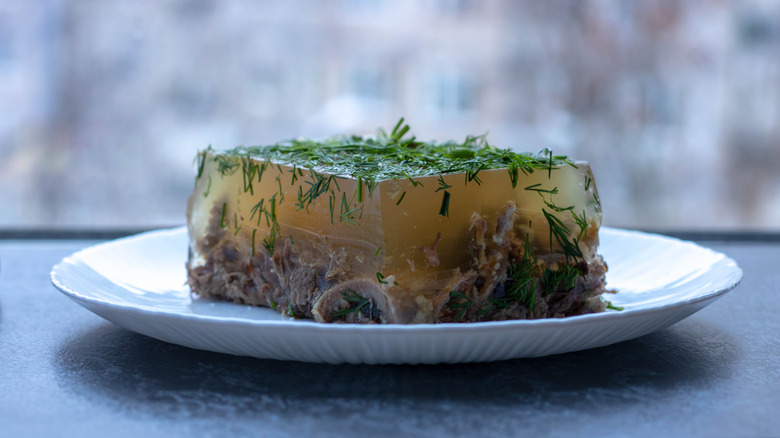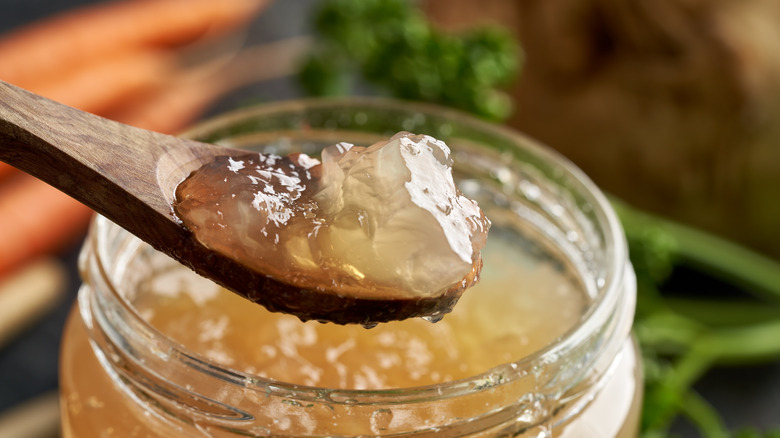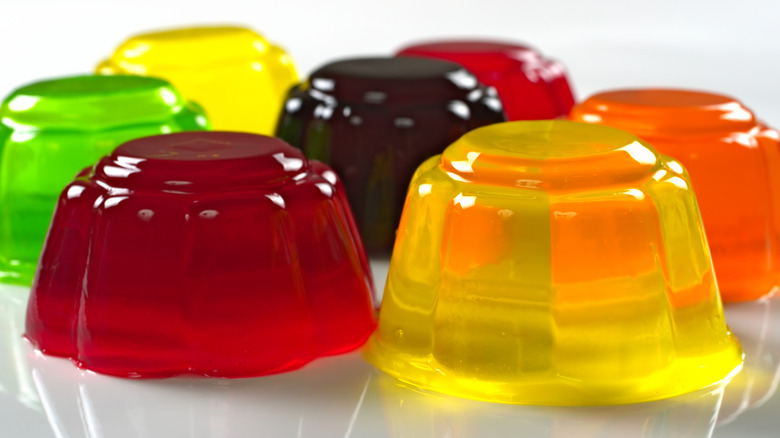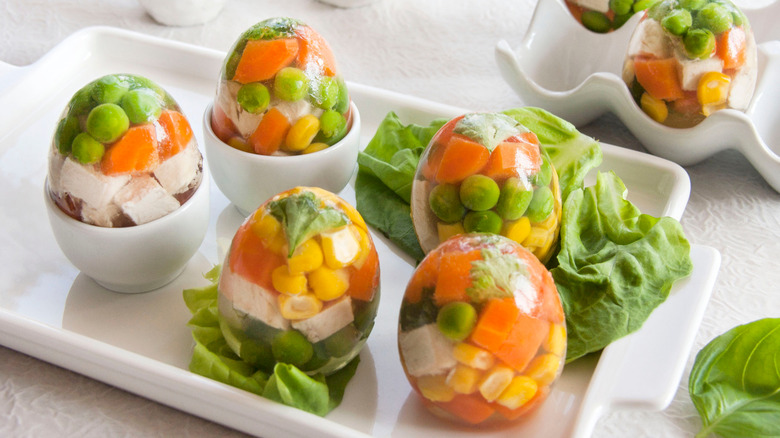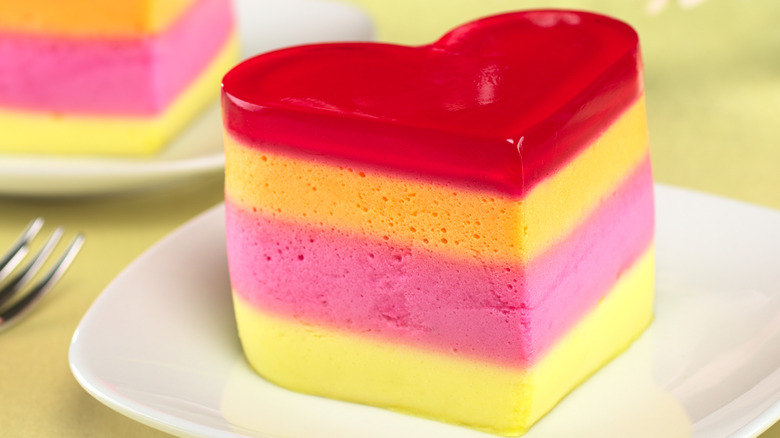The Difference Between Aspic And Jell-O
While Jell-O has been widely available since the early 20th century, and in fact seems to have been one of the staples of any mid-century menu, it's actually not the first jiggly food known to mankind (via Jell-O Gallery). That honor may go to aspic, something The Spruce Eats says has been around since the late 1300s. Aspic, unlike Jell-O, has long played a supporting role in what is considered to be "haute cuisine." In fact, the book "All Manners of Food" by Stephen Mennell describes one late 19th century banquet consisting of 56 dishes, each and every single one of which contained aspic. No matter how enamored you may be of wonderfully wobbly food, that's perhaps a bit too much of a good thing.
Besides isn't having a more high-falutin' pedigree, what sets aspic apart from Jell-O? Well, although they have a similar effect — turning clear(ish) liquids into jiggly solids — aspic and Jell-O achieve this end via different means, and they also tend to be used for different purposes. For the most part, aspic dishes are savory ones, while dishes made with sugary Jell-O can't help but be on the sweet side.
What exactly is aspic?
Aspic is one of those dishes that may well have evolved by accident. In fact, there's a chance you may have unintentionally created an aspic of your own without even trying. Basically, it's what you get when you boil up a bunch of bones, then let the broth cool until it thickens into a jelly. This jellied bone broth is most often used to set other types of food such as meats, vegetables, and boiled eggs into a mold. Aspic is actually kind of a pain to make if you're doing it deliberately.
In order to get meat broth to the point where it will set up in a jelled form, it has to be cooked low and slow for hours and hours, and even then, not every type of bone will produce the best results. The Spruce Eats suggests using chicken or pig's feet or perhaps pig or beef knuckles, while DoughMesstic says many home cooks recommend veal bones. You may also wish to add egg whites in order to clarify the broth if you want a translucent aspic. If you lack the right kind of bones or sufficient patience to boil them to the point where they're all set to gel, you can use plain gelatin powder to speed things along. True aspic is made from meat broth, though, so if you skip the meat altogether, you've got a flavored gelatin on your hands rather than an actual aspic.
So how is Jell-O different from aspic?
Jell-O itself is a specific brand, but by now it's pretty much a noun used to mean any fruit-flavored gelatin dessert, whether it be made from a generic mix or even homemade. The main difference between Jell-O (or fruit gelatin) and aspic is that while Jell-O gets its thickening power from the same biologically-based source as aspic, it goes out of its way to hide those origins.
This strawberry Jell-O label (courtesy of Harvard University Dining Services) says the ingredients include sugar, gelatin, adipic acid, artificial flavor, disodium phosphate and sodium citrate, fumaric acid, and red 40. Scary enough in its own way, but not quite as horrifying as disclosing what goes into that innocuous-sounding "gelatin" — this Jell-O ingredient is actually made from animal skin, tendons, ligaments, and, yes, bones. Still, in its powdered or sheet form, gelatin is sufficiently refined as to have no taste of its own, so it can easily take on any kind of flavoring you give it. For that reason, aspics, which still taste of bone broth, are nearly always used in savory dishes, whereas sweet, fruity Jell-O is most often used in dessert recipes.
How to make a vegetarian aspic
While a true aspic can't actually be vegetarian because of the meat bones from which it's made, it is possible to create a jellied vegetable broth using animal-free thickeners. Gelatin itself is not vegetarian, no matter what the label may not choose to disclose, but Fine Cooking says that there are two widely available plant-based gelling agents — agar and carrageenan (Irish moss), both of which are extracted from red algae.
If you'd like to try making your own veggie "aspic," Vegan Peace has a recipe for what they call a vegetable aspic terrine that starts with a flavorful vegetable stock thickened with flaked or powdered agar. You then layer an assortment of colorful cooked, sliced vegetables such as asparagus, carrots, and red bell peppers in the mold, covering each layer with cooled, slightly thickened consommé and allowing it to gel before adding the next layer. For added fanciness, you can finish off this congealed salad with a layer of pureed peas or asparagus.
What are some famous aspic dishes?
Aspic dishes had their heyday in the U.S. in the middle of the 20th century, which was also a big time for Jell-O . One of the best-known dishes of the jiggly foods era was tomato aspic, something the Happy Hollisters says was particularly popular at ladies' luncheons. From their description, it sounds like a vodka-free bloody Mary formed into a molded gelatin. Just think how much more popular it would have been with those lunching ladies had the dish included vodka, as well!
Today, aspic dishes are better known in Eastern Europe, a place they never fell out of favor. One such dish mentioned by The Spruce Eats is the Russian kholodets made from pig bones, and another is the equally pork-based popular Polish dish, jellied pigs feet. Oh, and let's not forget British jellied eels, once the crowning glory of Cockney cuisine but now, go figure, no longer quite as popular as once they were (via Vice). Still, you never know, perhaps these and other congealed dishes are due for a foodie revival.
These are some of Jell-O's greatest hits
Jell-O, in and of itself, is a rather one-dimensional product, and one that in its unadorned form is really not that exciting as dessert options go. There's a reason why "gourmet Jell-O" isn't a thing, and you're not going to see spiffed-up "gélatine de fruits" on too many high-end restaurant menus. In fact, having plain old Jell-O on the dessert menu at all is pretty much a dead giveaway that you're eating in an old-school diner (or an elementary school cafeteria). Over the past decades, however, the ever-inventive chefs in the Jell-O test kitchens have been hard at work coming up with an endless stream of recipes proving that their product can do so much more than just make jiggly squares.
Perhaps the best-known Jell-O upgrade is the much-maligned Jell-O salad. There's also the jiggle-free yet colorful Jell-O poke cake, and who could forget the notorious Jell-O shots of frat party fame? You can also experiment with making layered Jell-O, try your hand at Jell-O parfaits and Jell-O cheesecake, and even use Jell-O to make popsicles or possibly cure a sore throat. While today's Jell-O is more or less the same product it's been for the past century-plus, it can be far more than just grandma's go-to dessert if you just use your imagination (or Google's).
